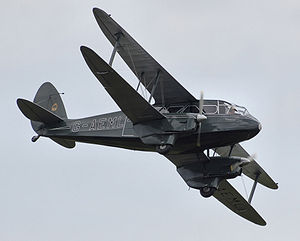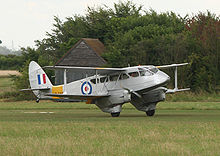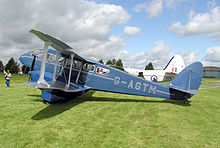- de Havilland Dragon Rapide
-
DH.89 Dragon Rapide/Dominie Role Short-haul airliner Manufacturer de Havilland First flight 17 April 1934 Primary user Royal Air Force Number built 731 The de Havilland DH.89 Dragon Rapide was a British short-haul passenger airliner of the 1930s.
Contents
Design and development
Designed by the de Havilland company in late 1933 as a faster and more comfortable successor to the DH.84 Dragon, it was in effect a twin-engined, scaled-down version of the four-engined DH.86 Express. It shared many common features with the larger aircraft including its tapered wings, streamlined fairings and the Gipsy Six engine, but it demonstrated none of the operational vices of the larger aircraft and went on to become perhaps the most successful British-built short-haul commercial passenger aircraft of the 1930s.
Operational history
Prewar operations
The prototype aircraft first flew at Hatfield on 17 April 1934 and 205 were built for airlines and other owners all around the world before the outbreak of World War II. Originally designated the "Dragon Six" it was first marketed as "Dragon Rapide" although later it was popularly referred to as the "Rapide". With the fitting of improved trailing edge flaps from 1936, they were redesignated DH.89As.
The type entered service with UK-based airlines in the summer of 1934 with Hillman Airways Ltd being first to take delivery in July. Railway Air Services (RAS) operated a fleet of Rapides from August 1934 on routes linking London, the north of England and on to Northern Ireland and Scotland. The RAS DH.89s were named after places on the network and (eg) "Star of Lancashire".[1]
Isle of Man Air Services operated a fleet of Rapides on scheduled services from Ronaldsway Airport near Castletown to airports in north-west England including Blackpool, Liverpool and Manchester. Some of their aircraft had been transferred to them after operation by Railway Air Services.
One famous incident involving the use of a DH.89 was in July 1936 when two British MI6 intelligence agents, Cecil Bebb and Major Hugh Pollard, flew Francisco Franco in one from the Canary Islands to Spanish Morocco, at the start of the military rebellion which began the Spanish Civil War.[2] You can see today in the Aeronautics and Astronautics Museum of Spain.
World War Two
At the start of World War II many (Dragon) Rapides were impressed by the British armed forces and served under the name de Havilland Dominie. They were used for passenger and communications. Over 500 further examples were built specifically for military purposes, powered by improved Gipsy Queen engines, to bring total production to 731. The Dominies were mainly used by the Royal Air Force and Royal Navy for radio and navigation training.
Other civilian Rapides continue to fly for UK airlines as part of the Associated Airways Joint Committee (AAJC). The AAJC co-ordinated the UKs wartime scheduled services which were entirely operated on over-water routes.
Many ex RAF survivors entered commercial service after the war, and 81 were still flying on the British register in 1958. Dominie production was by both de Havilland and Brush Coachworks Ltd, the latter making the greater proportion.
Postwar operations
The DH.89 proved an economical and very durable aircraft despite its relatively primitive plywood construction and many were still flying in the early 2000s. Several Rapides are still operational in the UK and several suppliers still offer pleasure flights in them. A Rapide can be seen in the Museum of Science and Industry in Manchester. Two Rapides are still airworthy in New Zealand. There is a Dragon Rapide flying with the Military Aviation Museum in Virginia Beach, Virginia, and another one based in Yolo County, California. Two are operated by Classic Wings for pleasure flights in UK.
Variants
- D.H.89
- Twin-engined light transport biplane. First production version.
- D.H.89A
- Improved version, fitted with a landing light in the nose, modified wingtips and cabin heating.
- D.H.89A Mk 4
- One D.H. 89A aircraft, powered by two de Havilland Gipsy Queen 2 piston engines, fitted with constant speed propellers.
- D.H.89A Mk 5
- One D.H.89A aircraft, powered by two de Havilland Gipsy Queen 3 piston engines, fitted with variable-pitch propellers.
- D.H.89A Mk 6
- One D.H.89A aircraft fitted with Fairey X5 fixed-pitch propellers.
- D.H.89M
- Military transport version. Exported to Lithuania and Spain.
- D.H.89B Dominie Mk I
- Radio and navigation training version.
- D.H.89B Dominie Mk II
- Communications and transport version.
Operators
Civil
- Canadian Pacific
- Quebec Airways
- Aero Oy operated two aircraft.
- Air India
- Indian National Airways
- Tata Airlines
- Aer Lingus
- Aer Turas operated one aircraft.
- Valsts Gaisa satiksme
- Air Travel (NZ) Ltd
- Mount Cook Airline
- National Airways Corporation
- Cook Strait Airways Ltd
- Palestine Airways (British Mandate of Palestine)
- Aviron
- Aerocarga Asociados ACA
- Comair (South Africa) operated 2 aircraft.
- Iberia
- Air Charter Limited
- Air Atlantique Classic Flight
- Airviews Ltd
- British European Airways
- Classic Wings
- British Westpoint
- Crilly Airways Ltd
- Hillmans Airways
- Isle of Man Air Services
- Jersey Airways
- Lancashire Aircraft Corporation
- Mayflower Air Services
- Melba Airways
- Olley Air Services
- Railway Air Services
- Scillonia Airways
- Scottish Airways
- Sivewright Airways
- Starways
- Trans European Aviation
- Westward Airways (Lands End)
Military operators
- Belgian Air Force (Seven operated from 1946)
- Royal Egyptian Air Force
- Luftwaffe operated captured aircraft.
- Imperial Iranian Air Force
- Lithuanian Air Force operated two D.H.89M aircraft.
- Royal Netherlands Air Force - four D.H.89B Mark II (transports)
- No. 334 Squadron RNLAF (1944–1956)
- Southern Rhodesian Air Force - Four aircraft.
- Spanish Republican Air Force operated three D.H.89M.
- United States Army Air Force
- Royal Yugoslav Air Force - One aircraft impressed into military service in 1940.
Accidents and incidents
- On 2 October 1934 G-ACPM of Hillman's Airways crashed into the sea off Folkstone, Kent causing the death of the pilot and the six passengers.
- On 26 January 1935, G-ACPO of Hillman's Airways, operating a mail flight from Aldergrove Airport, Belfast to Stapleford Aerodrome, Abridge, Essex via Speke Airport, Liverpool, Lancashire crashed at Derbyhaven, Isle of Man, whilst attempting to divert to Ronaldsway Airport during bad weather.[3]
- On 28th June 1946 VP-KCU Crashed landed out of fuel near Lamu Kenya. No loss of life.
- On 15 April 1947, G-AHKR of British European Airways crashed into Slieu Ruy whilst operating a scheduled passenger flight from Speke Airport, Liverpool, Lancashire to Ronaldsway Airport, Isle of Man. There were only minor injuries amongst the six people on board.[4]
- On 10 June 1948, G-AIUI of Hargreaves Airways crashed at Cronk ny Arrey Laa, Isle of Man. Seven of the nine people on board were killed. The aircraft was operating a scheduled passenger flight from Speke to Ronaldsway.[5]
- 10 July 1951, G-ALXJ of the Air Navigation and Trading Company crashed into the sea off Laxey, Isle of Man, killing the pilot. The aircraft was operating a scheduled cargo flight from Squires Gate Airport, Blackpool, Lancashire to RAF Jurby instead of its normal destination of Ronaldsway Airport, which was fogbound.[6]
- 19 February 1954, G-AFMF crashed into Simonburn Common near Hexham. Pilot and 7 passengers escape with minor injuries.[7]
- 29 June 1957, G-AGUE of Island Air Services crashed on take-off from Ramsgate Airport, Kent on a local pleasure flight. The aircraft was written off but all on board escaped uninjured.[8]
- 16 July 1960, OY-DZY of Zonens Redningskorps crashed shortly after take-off from Copenhagen Airport, Denmark. The aircraft was chartered by the Danish Football Association to transport soccer players to a test match in Jutland. All eight passengers are killed; the pilot survives but has one leg amputated.[9][10]
Specifications (Dragon Rapide)
General characteristics
- Crew: 1
- Capacity: 8 passengers
- Length: 34 ft 6 in (10.5 m)
- Wingspan: 48 ft 0 in (14.6 m)
- Height: 10 ft 3 in (3.1 m)
- Wing area: 340 ft² (32 m²)
- Empty weight: 3,230 lb (1,460 kg)
- Loaded weight: 5,500 lb (2,490 kg)
- Powerplant: 2 × de Havilland Gipsy Six inline engine, 200 hp (149 kW) each
Performance
- Maximum speed: 157 mph (136 kn, 253 km/h) at 1,000 ft (305 m)
- Range: 573 mi (498 nmi, 920 km)
- Service ceiling: 16,700 ft (5,090 m)
- Rate of climb: 867 ft/min (4.3 m/s)
- Wing loading: 16 lb/ft² (79 kg/m²)
- Power/mass: 0.036 hp/lb (60 W/kg)
Notable appearances in media
A de Havilland Dragon Rapide, the Sky Gypsy, appears in Out of Time, an episode of the BBC science fiction television series Torchwood, in which one is accidentally flown through a "transcendental portal" and travels from 1953 over 50 years into its passengers' future. Aircraft registered as G-ACZE appears in the 1990 BBC production Agatha Christie's Poirot, "Peril at End House". Dragon Rapides appear in several films including The Maggie, The Captain's Paradise, Fathom, and the 1995 film adaptation of Shakespeare's Richard III.
A 1986 Spanish film, Dragon rapide[11], covers its historical use by Generalissimo Francisco Franco.
See also
- Related development
- Related lists
References
Notes
- ^ Jackson, 1978, pp.362-363
- ^ Alpert, Michael BBC History Magazine April 2002
- ^ Poole 1999, p. 12.
- ^ Poole 1999, pp. 120-21.
- ^ Poole 1999, pp. 121-22.
- ^ Poole 1999, pp. 126-27.
- ^ ASN Aircraft accident 19-FEB-1954 de Havilland DH.89A Dragon Rapide G-AFMF, accessed 08 November 2011.
- ^ Humphreys 2001, p. 169.
- ^ "I dag er et trist jubilæum for dansk fodbold", Politiken, 16 July 2010, accessed 09 September 2011.
- ^ CNAPG Dragon Rapide Individual Aircraft History Page, accessed 09 September 2011.
- ^ [1]
Bibliography
- Hamlin, John F. The De Havilland Dragon Rapide Family. Tunbridge Wells, Kent, UK: Air-Britain (Historians) Ltd., 2003. ISBN 0-85130-344-7.
- Jackson, A.J. De Havilland Aircraft since 1909. 1978. Putnam & Company Ltd. isbn 0-370-30022-X
- Humphreys, Roy (2001). Kent Aviation, A Century of Flight. Stroud: Sutton Publishing. ISBN 0-7509-2790-9.
- Jackson, A.J. British Civil Aircraft 1919-1972: Volume II. London: Putnam (Conway Maritime Press), 1988. ISBN 0-85177-813-5
- Poole, Stephen (1999). Rough Landing or Fatal Flight. Douglas: Amulree Publications. ISBN 1 901508 03 X.
External links
- Fighter Factory's de Havilland Dragon Rapide
de Havilland and Airco aircraft By manufacturer
designation- DH.1
- DH.2
- DH.3
- DH.4
- DH.5
- DH.6
- DH.9 / DH.9A / DH.9C
- DH.10
- DH.11
- DH.12
- DH.14
- DH.15
- DH.16
- DH.17
- DH.18
- DH.19
- DH.20
- DH.21
- DH.22
- DH.23
- DH.24
- DH.25
- DH.26
- DH.27
- DH.28
- DH.29
- DH.30
- DH.31
- DH.32
- DH.33
- DH.34
- DH.35
- DH.36
- DH.37
- DH.38
- DH.39
- DH.40
- DH.41
- DH.42
- DH.43
- DH.44
- DH.45
- DH.46
- DH.47
- DH.48
- DH.49
- DH.50
- DH.51
- DH.52
- DH.53
- DH.54
- DH.55
- DH.56
- DH.57
- DH.58
- DH.59
- DH.60
- DH.61
- DH.62
- DH.63
- DH.64
- DH.65
- DH.66
- DH.67
- DH.68
- DH.69
- DH.70
- DH.71
- DH.72
- DH.73
- DH.74
- DH.75
- DH.76
- DH.77
- DH.78
- DH.79
- DH.80
- DH.81
- DH.82
- DH.83
- DH.84
- DH.85
- DH.86
- DH.87
- DH.88
- DH.89
- DH.90
- DH.91
- DH.92
- DH.93
- DH.94
- DH.95
- DH.96
- DH.97
- DH.98
- DH.99
- DH.100
- DH.101
- DH.102
- DH.103
- DH.104
- DH.105
- DH.106
- DH.107
- DH.108
- DH.109
- DH.110
- DH.111
- DH.112
- DH.113
- DH.114
- DH.115
- DH.116
- DH.117
- DH.118
- DH.119
- DH.120
- DH.121
- DH.122
- DH.123
- DH.124
- DH.125
- DH.126
- DH.127
- DH.128
- DH.129
- DH.130
By role FightersBombersPassengerSportsTrainersRacersTechnical School Lists relating to aviation General Aircraft (manufacturers) · Aircraft engines (manufacturers) · Airlines (defunct) · Airports · Civil authorities · Museums · Registration prefixes · Rotorcraft (manufacturers) · TimelineMilitary Accidents/incidents Records Categories:- British airliners 1930–1939
- British military utility aircraft 1930–1939
- De Havilland aircraft
Wikimedia Foundation. 2010.








